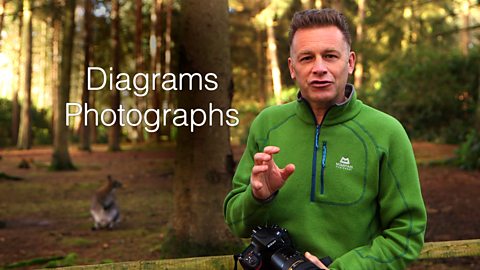SONALI SHAH: Hi IÔÇÖm Sonali Shah, and IÔÇÖm a journalist who covers sport, and my job is to present information to an audience in a clear and effective way.
Today IÔÇÖll be writing a ÔÇśnon-chronologicalÔÇÖ report. Basically IÔÇÖm telling a factual story, but I donÔÇÖt have to write it in the order in which things happened.
Instead I can arrange the information in a way that will be more interesting to the reader, thatÔÇÖs why itÔÇÖs called ÔÇśnon-chronologicalÔÇÖ writing.
When you are writing a report itÔÇÖs always good to have a structure, a plan. WeÔÇÖll begin with the title, then comes the introduction, then IÔÇÖll need to think about the main paragraphs, and I can finish things off with a summary. Now IÔÇÖve got a plan which will help me as I write the report.
So first things first, what am I going to call my report? I need a catchy title, something thatÔÇÖs really going to grab the audienceÔÇÖs attention. You want them to read the title, and want them to want more information.
Now my story is about the medical tests that footballers have during the transfer window, so IÔÇÖm going to keep it really simple and go with a question as my title, ÔÇśWhat happens in a football medical?ÔÇÖ.
Now I need to write an introduction, and this should explain what the story is. Here goesÔÇŽ ÔÇśÔÇťA dealÔÇÖs been done subject to a medicalÔÇŁ. These are the words we hear throughout the Premier League transfer window. The fees have been agreed and the personal terms have been sorted, now itÔÇÖs time for the final hurdle in negotiations ÔÇô a playerÔÇÖs medical examination.ÔÇÖ
There, after a few drafts IÔÇÖve finished my introduction. Now when youÔÇÖre writing itÔÇÖs always good to have a few goes at it, to make sure itÔÇÖs just right.
Now itÔÇÖs time to write my main paragraphs. Now these will be the biggest part of my report, which means I need something to help me write it ÔÇô content, which needs to be detailed and informative.
I need facts for my report, and you can get facts from a range of resources. The internet is the most obvious resource, but itÔÇÖs also good to talk to people. I went to interview people that knew more about football transfers than I did. Newspapers are also a good resource.
IÔÇÖm confident my research is correct and the best I can find, so itÔÇÖs time to write my paragraphs.
Now most of your report will be written in the present tense, so youÔÇÖll be using words like ÔÇśIsÔÇÖ, ÔÇśDoesÔÇÖ, or ÔÇśHasÔÇÖ. But if something has happened in the past, use the past tense, with words like ÔÇśWasÔÇÖ, ÔÇśDidÔÇÖ or ÔÇśHadÔÇÖ.
Now remember this is a ÔÇśnon-chronologicalÔÇÖ report, which means you donÔÇÖt have to write things in the order that they happened. So for my story, I donÔÇÖt need to say ÔÇťA footballer came through the door, and then had his medical test, and then he leftÔÇŁ. The medical test is the most important thing in the story, so I can actually start with it.
Always think about your audience, who they are, what age they are. So if you are writing for C91╚╚▒ČÔÇÖs Newsround you can use different language than if you were writing for 91╚╚▒Č Sport online, which your mums and dads would be reading.
Now my report is almost finished, thereÔÇÖs just the summary left to write, and the summary should bring together all the key points that have been written in the main report.
When you finish writing your report, itÔÇÖs wise to re-read your paragraphs to check for spelling or grammar mistakes. This is known as ÔÇśproof-readingÔÇÖ. Even the best journalists can make mistakes so itÔÇÖs important to double check your spelling, your punctuation, your grammar. Do your sentences make sense?
The easiest way to double or triple check is by reading your whole report out aloud. DonÔÇÖt worry about the funny looks, itÔÇÖs more important to get it right.
Now IÔÇÖm happy with my report, so all I need to do is press send!
Video summary
91╚╚▒Č journalist Sonali Shah explains how writing non-chronological reports requires an understanding of the planning, writing and drafting process.
Sonali takes you through the process from start to finish; identifying the key features of non-chronological writing and emphasising the importance of researching, drafting and proof-reading in her job as a journalist.
She also explains how important it is to engage the reader by using appropriate vocabulary.
This short film is from the 91╚╚▒Č series, The Facts About Non-Fiction.
Teacher Notes
Watch this short film together and ask your pupils to consider the following questions:
What is needed to write a good non-chronological report?
What features are required? Can you remember any technical language to describe the features?
When writing a non-chronological report, what format should it take?
As a group, come up with a list of the criteria required to write a successful non-chronological report.
Pupils could then write their own. These could either be related to aspects of the curriculum ÔÇô science, geography, history; or pupils could write reports which express their own interests.
This short film will be relevant for teaching English at KS1 and KS2 in England, Wales and Northern Ireland and 1st and 2nd Level in Scotland.
How to write clear instructions. video
Stefan Gates explains how writing a set of instructions requires use of simple, precise language, and an understanding of chronological order and imperative verbs.

How to write a persuasive text. video
Actors Shannon Flynn and Richard Wisker talk about using emotive language, the difference between facts and opinions, and how to use evidence to support persuasive writing.

How to write a discussion text. video
Newsround presenter Leah Boleto explains how discursive writing requires an understanding of the difference between facts and opinions, and how to use connecting phrases and statistics.

How to write a recount. video
Michael Rosen explains how writing a recount requires an understanding of chronological order or sequencing, and how to structure a piece of writing.

How to write an explanation. video
Chris Packham explains how writing an explanation requires an understanding of chronological order or sequencing, how to use technical language and how to write succinctly.
